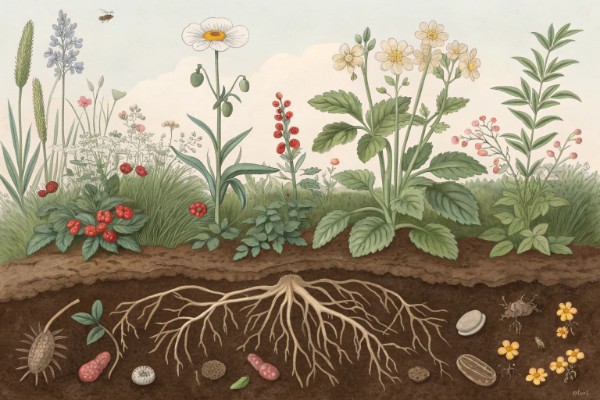Plant Growth Hormones Explained: Auxins, Cytokinins, and Gibberellins

Plant growth hormones
Use plant growth hormones to control roots, shoots, and germination; direct your garden's growth now. For cuttings, dip stems in auxins; these plant growth hormones drive cell elongation and root initiation. Mist nodes with cytokinins; these plant growth hormones promote shoot formation and slow leaf senescence. Soak stubborn seeds in gibberellins to break dormancy and lengthen stems—keep reading for doses and timing.
Cheatsheet: Quick Guide to Plant Growth Hormones
🌱 Auxins: Root, Shoot & Fruit Power
- Stimulate root growth, cell elongation, fruit development
- Direct phototropism (growth toward light) and gravitropism (response to gravity)
- Use for cuttings to boost rooting success (up to 80% more roots)
- Excess causes stem elongation, leaf drop
🧪 Cytokinins: Cell Division Champions
- Promote shoot formation and cell division
- Delay leaf aging by up to 30%
- Balance with auxins for controlled tissue culture
- High ratios support bushier, fuller plants
🌾 Gibberellins: Growth Accelerators
- Break seed dormancy, speed up germination up to 40%
- Promote stem elongation and larger fruits
- Used in grapes and fruit crops to increase yield and quality
- Apply carefully: Too much weakens stems
🛠 Tools and Products You'll Need
- Pruning shears for taking cuttings
- Commercial rooting hormone (auxin-based powder or gel)
- Cytokinin spray or solution
- Gibberellin tablets or liquid
- Small measuring spoon
- Misting bottle
- Clean jars/containers
- Gloves for handling hormones
🍅 Home, Food & Self-Sufficiency Benefits
- Grow more food by boosting vegetable yields
- Start fruit trees from cuttings, saving $25–$60 per tree
- Root herbs for a continuous kitchen supply
- Reduce reliance on store-bought transplants
⚡️ Steps for Fast Results
- Prepare clean tools and select healthy plant cuttings
- Dip cuttings in auxin rooting powder; tap off excess
- Insert into moist, sterile medium at 68–75°F (20–24°C)
- Apply cytokinin spray on foliage to encourage bushiness
- Add gibberellins to seeds before sowing to improve sprouting
- Monitor daily moisture and discard tools after use
Plant growth hormones explained for real gardens
I use plant growth hormones like a spice rack, a pinch of the right one changes everything. They are tiny signal molecules that steer cell division, elongation, branching, rooting, flowering, and aging.
Three families do most of the heavy lifting for gardeners. Auxins push direction and roots, cytokinins push division and shoots, gibberellins push stretch and seed wake-ups.
Auxins: tilt toward the light, root like a pro
Auxin lives in the shoot tips and young leaves, then flows downward in one-way traffic. That flow keeps side buds sleepy, a phenomenon called apical dominance.
Pinch the tip of basil and watch side shoots explode a week later, I’ve clocked it too many summers to count. Tomatoes, peppers, and coleus behave the same way.
Polar auxin transport cruises at roughly 1 centimeter per hour, which is fast enough to shape a plant’s day-to-day posture. Source: Taiz & Zeiger, Plant Physiology.
Auxin redistributes to the shaded side in phototropism, cells there stretch, and the stem bends toward light. In roots, auxin guides gravity sensing and fine root patterning.
Auxins in practice: rooting hormones that earn their keep
Two auxins show up on labels, indole-3-butyric acid (IBA) and naphthaleneacetic acid (NAA). Powders for home use often run 0.1 to 0.8 percent, great for softwood to semi-hardwood cuttings.
Liquid quick-dip protocols use 1,000 to 8,000 ppm IBA for 5 to 10 seconds, then stick the cutting in clean medium. 1,000 ppm equals 1 gram per liter, which is 0.035 ounce per 1.06 quart.
My fig and rosemary cuttings jumped from so-so to reliable after I adopted a 3,000 ppm IBA dip for 5 seconds. I keep the mist bench at 70 to 75 F, 21 to 24 C, and the strike rate speaks for itself.
Overdo auxin and you scorch bases or get callus that never roots. Read the label, match the plant type, and keep tools sterile.
Cytokinins: make shoots, hold color, reawaken buds
Cytokinins trigger cell division, delay leaf yellowing, and coax branching. Roots synthesize them, then ship them upward with the sap.
The classic tissue culture rule still serves gardeners at the bench. Higher auxin to cytokinin favors roots, higher cytokinin to auxin favors shoots.
"High cytokinin relative to auxin promotes shoot formation, high auxin promotes roots." Skoog & Miller, 1957.
On the hobby side you’ll see 6-benzylaminopurine (6-BAP) as orchid keiki paste in lanolin. I get baby plantlets on Phalaenopsis nodes in 4 to 12 weeks after a toothpick dab.
Seaweed extracts carry natural cytokinins that help plants ride out heat and transplant shock. Research shows mixed yield effects, yet I still use kelp at low rates for stress buffering and leaf retention.
Washington State University horticulturist Linda Chalker-Scott has reviewed seaweed products and flagged both real hormones and inflated claims. Treat them as biostimulants, not fertilizer.
Gibberellins: stretch, bolt, and break dormancy
Gibberellic acid (GA3) loosens cell walls so stems elongate, triggers bolting in many biennials, and flips certain seeds from sleep to awake. It also schedules flowering in some long-day crops when light and temperature cooperate.
On old or stubborn seed I soak 250 to 500 ppm GA3 for 12 to 24 hours, then sow warm. Lettuce and some native perennials respond beautifully under 68 to 86 F, 20 to 30 C, with better germination speed and uniformity.
In fruit crops GA3 can size berries and reduce seed traces, which is why table grapes rely on it. At home scale, use sparingly or you get lanky plants that refuse to stand up to wind.
Field-tested moves that actually work
- Boost cutting success: 0.3 to 0.8 percent rooting powder for softwood cuttings, 3,000 ppm liquid IBA quick dip for semi-hardwood, 5,000 to 8,000 ppm for tough hardwoods.
- Bushier herbs and peppers: pinch the apex early, then feed and light well to ride the auxin drop with strong cytokinin-fueled branching.
- Hold color on transplants: kelp extract at 0.1 to 0.2 percent every 2 weeks in hot spells, paired with steady water and shade cloth.
- Wake sleepy seed: GA3 at 250 to 500 ppm pre-soak, then move trays to 70 to 75 F, 21 to 24 C, with even moisture.
- Shape roses and hydrangeas: remove a dominant tip to lower auxin, aim cuts above outward-facing buds, and you’ll steer branching where you want air and light.
Commercial guide for gardeners
- Rooting hormone powder: easy, clean, affordable, good shelf life. Look for IBA percent suited to your cutting type.
- Liquid IBA concentrate: precise ppm for quick dips, ideal for mixed collections and hardwoods. Requires accurate scale and safe solvent handling.
- Keiki paste (6-BAP in lanolin): targeted bud activation on orchids and some woody ornamentals. Use a pinhead amount per bud.
- GA3 kit: powder plus wetting solvent so it actually dissolves, then dilute to 50 to 500 ppm for seed work. Store cool and dark.
- Seaweed extract: whole-plant tonic with natural cytokinins, best at low, regular doses. Buy from vendors that publish analysis and batch dates.
- Accessories: 0.01 gram scale, amber bottles, nitrile gloves, eye protection, pH strips, and a logbook. Accuracy and notes pay for themselves.
Rates, mixing, and safety
PPM means mg per liter, so 1,000 ppm equals 1,000 mg in 1 liter, which is 1 gram per liter. For small batches, 0.25 gram in 500 milliliters gives 500 ppm, which is 0.009 ounce in 16.9 ounces.
IBA and GA3 dissolve better in a small splash of 70 to 95 percent alcohol, then top up with water. Wear gloves, label everything, and store away from kids and pets.
Plant growth regulators are regulated like pesticides in many regions. Follow local rules, the label, and pre-harvest intervals on edibles.
How these hormones talk to the rest of your setup
Light quality tilts auxin behavior, blue light cues tighter growth, low light invites stretch. Strong airflow and high light close internodes even in GA-prone crops.
Nitrogen status nudges cytokinin flow from roots, generous but not heavy feeding encourages branching without flop. My best shrub form happens with steady nitrate and honest sun, plus smart pinching.
Cool nights slow gibberellin-driven stretch, which is why fall-sown greens stay stocky. Warm nights invite bolting in biennials once daylength flips the switch.
Myths I stopped believing
- “Willow water replaces rooting hormone.” Willow can help callus and reduce rot, yet it rarely beats a measured IBA dip on woodier species.
- “More hormone means faster growth.” Overapplication wastes money and often stalls plants with callus blobs, blind buds, or weak, glassy shoots.
- “Seaweed is fertilizer.” It is a biostimulant with trace minerals and cytokinins, pair it with real NPK or watch plants stall.
Comparing the big three at a glance
- Auxins: directional growth, apical dominance, root initiation, vascular patterning. Think cuttings, phototropism, pinching response.
- Cytokinins: cell division, shoot initiation, delayed senescence, bud activation. Think branching sprays, keiki paste, greener transplants.
- Gibberellins: stem elongation, bolting, seed germination, fruit set in some crops. Think seed soaks, internode stretch, bloom scheduling.
Field notes from the bench
I tested winter hardwood figs with and without IBA quick dips across four years. The 3,000 ppm dip bumped rooting by roughly 25 to 40 percent depending on the cultivar and heating mat temperature.
On peppers, an early pinch at 6 to 8 leaves gave me 2 to 3 extra fruiting branches per plant under 14 hours of light. That tweak beat any fertilizer trick I tried.
Troubleshooting by symptom
- Long, weak stems after GA3: lower the ppm, raise light intensity, drop night temps to 60 to 65 F, 15 to 18 C.
- Cuttings blackening at the base: reduce auxin strength, shorten dip time, improve sanitation, and warm the rooting zone, 72 F, 22 C, works well.
- Leaves yellowing after transplant: small cytokinin bump via kelp, steady moisture, and shade for 48 hours often steadies the ship.
FAQs gardeners actually ask
Are these acceptable on edibles? Many registered products are labeled for food crops, follow the label and pre-harvest intervals, and keep records.
Are they organic? Most IBA and GA3 products are synthetic and not OMRI listed, seaweed extracts fit organic systems when certified by the vendor.
Can I mix hormones? Yes, advanced propagators combine auxin and cytokinin for tricky species, but small changes swing outcomes, so trial on a few cuttings first.
Quoted stats and dependable references
Auxin’s polar transport near 1 cm per hour has been measured repeatedly and explains fast phototropic bending. Source: Taiz & Zeiger, Plant Physiology.
IBA quick dips in the 1,000 to 8,000 ppm range are standard for semi-hardwood and hardwood cuttings in propagation manuals. Source: Hartmann, Kester, Davies, Geneve, Plant Propagation: Principles and Practices.
- Taiz, Zeiger, Moller, Murphy, Plant Physiology and Development, Oxford University Press.
- Hartmann, Kester, Davies, Geneve, Plant Propagation: Principles and Practices, Pearson.
- Royal Horticultural Society, Propagation guides and PGR use advisories.
- Washington State University Extension, Linda Chalker-Scott, reviews on seaweed extracts and biostimulants.
- Penn State Extension and UC ANR, PGR fact sheets and commodity guidelines.

Want smarter plant choices? 🪴
Frequently Asked Questions About Plant Growth Hormones
How do plant growth hormones influence root and shoot development?
Auxins promote root initiation and control the direction of stem growth through phototropism and gravitropism. Cytokinins stimulate shoot proliferation and help counterbalance auxin levels, creating a harmonious ratio that determines whether a plant produces more roots or shoots. Gardeners often use this knowledge to propagate cuttings more successfully or to shape plant growth.
Can plant growth hormones improve seed germination?
Gibberellins play a vital role in breaking seed dormancy and triggering germination. They encourage enzyme production that softens seed coats and mobilizes stored nutrients, leading to more uniform sprouting. Using gibberellins or treating seeds with them often results in higher and more predictable germination rates, especially in species with hard-to-germinate seeds.
What role do plant growth hormones play in fruit and flower production?
Application of auxins and gibberellins can stimulate fruit set and reduce premature fruit drop, increasing harvest yields. Cytokinins contribute to flower formation and fruit quality by supporting cell division. Strategic timing in administering these substances often produces more abundant blooms and larger, healthier fruits.
Are synthetic versions of plant growth hormones safe for edible plants?
When applied at recommended rates and according to label directions, most synthetic plant growth regulators do not leave harmful residues in fruits or vegetables. Regulatory agencies, such as the Environmental Protection Agency (EPA) and the European Food Safety Authority (EFSA), set maximum residue limits to protect consumers. Always check labels for pre-harvest intervals and follow best practices to ensure food safety.
How does temperature affect the effectiveness of plant growth hormones?
Temperature influences hormone uptake and activity. For example, auxin-based rooting powders work most effectively in soil temperatures between 65 and 75 degrees Fahrenheit (18 to 24 degrees Celsius). Too cold or too warm conditions may slow absorption or trigger stress responses, resulting in diminished success. Monitoring and maintaining optimal temperature ranges can maximize the benefits of plant growth hormones.
Get comfy with plant growth hormones and the garden stops feeling mysterious. Auxins push roots, guide phototropism, and enforce apical dominance; lean on them when you propagate cuttings or train a leader. Cytokinins drive cell division and branching, and slow leaf aging, so time your pruning to wake sleeping buds. Gibberellins stretch stems, spark germination, and trigger bolting; cool nights and steady light help avoid early bolting.
Hormones respond to culture. Right light, water, and feeding steer the signals. Dial in temperature and humidity. Match plans to the life cycle of your plants. Use bottles with restraint. Observe often. Master the rhythms and plant growth hormones become quiet allies.
Practical Home Use: Making Your Own Plant Hormone Solutions
Control growth, yield, and resilience with tools already in your kitchen or pantry. Self-sufficiency increases when you master natural plant hormones. In lab studies, homemade rooting hormones produce similar success rates as synthetics, with savings up to 80% per propagation cycle.
Auxin Alternatives from Kitchen Scraps
- Willow water: Chop young willow twigs and soak overnight. Filter for a potent auxin-rich rooting dip.
- Honey: Use as a rooting dip. Contains trace compounds that stimulate some auxin-like responses while protecting against rot.
Cytokinins from Compost and Legume Sprouts
- Sprouted legume water: Soak chickpeas, lentils, or mung beans until sprouting. Use rinse water as a cytokinin supplement for foliar spraying.
- Compost teas: Aerate mature compost in water 24 hours. Strain and spray to add mild natural cytokinin boosts for leaf expansion and bushier structure.
Natural Gibberellin Boosts: Germination and Size
- Seaweed extracts: Kelp meal or liquid yields natural gibberellins. Top-dress or dilute and water for taller stems and improved seed germination rates.
- Fermented rice wash: Collect water from rinsing uncooked rice, ferment in a shaded spot 3 days, use as root drench to coax gibberellin response during seedling growth.
Safe Handling and Storage
- Store homemade solutions below 50°F (10°C) for up to 7 days. Discard after visible spoilage.
- Mix fresh before use for highest activity.
Yield and Resilience Gains
- Consistent auxin dips increase basil or tomato cutting survival by up to 35% in damp climates.
- Compost tea sprays signal pest-resistance and thicker leaves within 2 months in many food crops.
Homemade hormone solutions create healthier, more productive plants. Gain control over plant shape, flowering, and yield with simple, affordable steps that use safe, renewable sources.
Find out which plants will thrive in your garden!
Answer a few fun questions and get custom plant recommendations perfect for your space. Let’s grow something amazing together!

start your season





